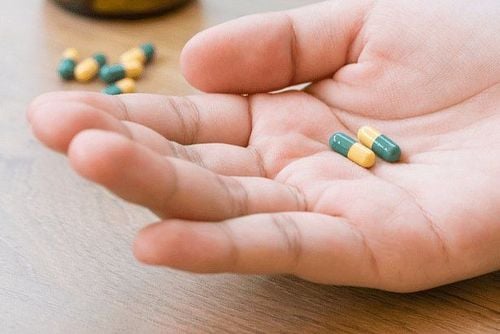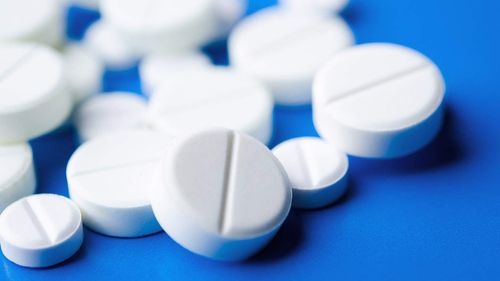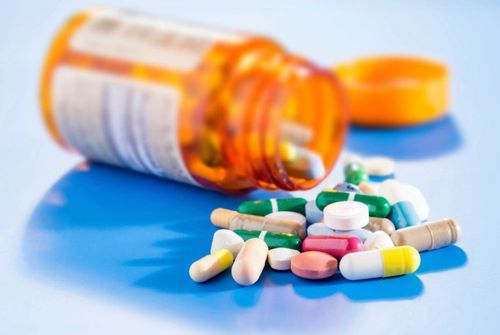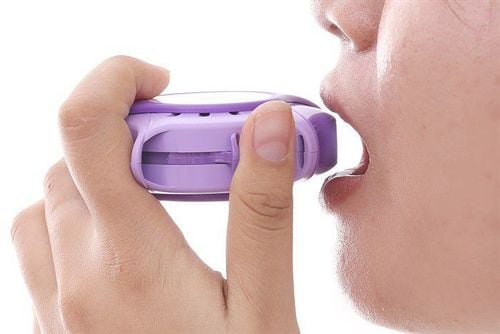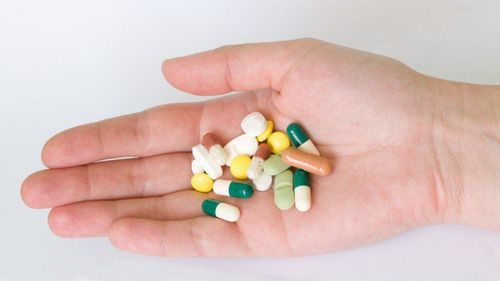This is an automatically translated article.
Singulair medicine containing the active ingredient Montelukast is indicated in the treatment and prevention of chronic bronchial asthma, including daytime and nighttime asthma symptoms, treatment and prevention of aspirin-sensitive asthma, and prevention of exacerbations. bronchospasm due to exertion... Let's learn about the uses, dosage and notes when using Singulair through the article below.
1. Uses of Singulair
1.1. Indications “What does Singulair do?” . Singulair contains the active ingredient Montelukast, which is available in the form of 10mg film-coated tablets, 5mg chewable tablets and 4mg chewable tablets. The drug is indicated in the treatment of the following medical conditions:
Prophylaxis and treatment of chronic asthma attacks in children over 6 months of age and adults, including the symptomatic prophylaxis of daytime and primary asthma. night, treatment of asthma in people sensitive to aspirin; Prophylaxis of exercise-induced bronchospasm; Relieving daytime and nighttime symptoms of allergic rhinitis (seasonal allergic rhinitis in adults and children 2 years of age and older, perennial allergic rhinitis in children over 6 months of age) and adults). 1.2. Pharmacodynamics Eicosanoids with potent pro-inflammatory potential include cysteinyl leukotrienes (LTC4, LTE4, LTD4) secreted from a variety of cell types, including eosinophils, granulocytes. These pro-asthmatic mediators bind to the cysteinyl leukotriene (CysLT1) receptor. CysLT1 receptors are implicated in the pathogenesis of allergic rhinitis and bronchial asthma. In asthma, Leukotriene-mediated effects include effects on the airways such as mucus secretion, bronchoconstriction, eosinophil mobilization, and increased capillary permeability. In allergic rhinitis, CysLT is secreted from the nasal mucosa after exposure to allergens, increasing airway obstruction as well as nasal obstruction symptoms.
Oral active ingredient Montelukast has anti-inflammatory properties that improve inflammatory parameters in asthma. Based on pharmacological and biochemical tests, montelukast shows a high and selective affinity for the CysLT receptor (this effect is predominant at other and pharmacologically important receptors such as cholinergic receptors, prostanoid or beta-adrenergic receptors). The drug strongly inhibits the physiological effects of LTD4, LTC4 and LTE4 at the CysLT1 receptor without agonist effects.
In patients with bronchial asthma, montelukast has an inhibitory effect on airways cysteinyl leucotriene receptors through its ability to inhibit bronchoconstriction caused by inhalation of LTD4. With a dose of less than 5mg, it has been shown to block the bronchospasm caused by LTD. The drug has a bronchodilator effect 2 hours after oral administration, which is synergistic with bronchodilator use by β-agonists.
1.3. Pharmacokinetics Absorption: The drug Montelukast after oral administration is rapidly and completely absorbed. The effect of the drug singulair 10mg is achieved 3 hours after taking the drug for adults, taking the drug on an empty stomach. The bioavailability of the drug orally is 64% and is not affected by a standard meal. For the 5mg chewable tablet, Cmax is reached 2 hours after dosing on an empty stomach, bioavailability for this dosage form is 73%. For the dosage form of a 4mg chewable tablet, the Cmax concentration of the drug was reached 2 hours after dosing in pediatric patients 2-5 years old taking the drug on an empty stomach. The 4mg granule form is bioequivalent to the 4mg chewable tablet form when administered to adults on an empty stomach.
Distribution: The drug is highly bound to plasma proteins (about 99%). The volume of distribution of the drug at steady state ranges from 8 to 11 liters. Studies in rats with montelukast have shown little distribution across the blood-brain barrier.
Metabolism: Montelukast is rapidly and strongly metabolized. In studies at therapeutic doses, plasma concentrations of the metabolite of montelukast were not found at steady state in adults and children. In vitro studies have shown that cytochromes P450 3A4 and P450 2C9 catalyze the metabolism of montelukast; therapeutic plasma concentrations do not inhibit cytochromes P450 2C9, 3A4, 2A6, 1A2 or 2D6.
Excretion: The plasma clearance of the drug is 45 mL/min in healthy adults. After oral administration, approximately 86% of the tracer was recovered in the feces for 5 days and less than 0.2% of the drug was excreted in the urine. This also shows that Montelukast and its metabolites are excreted almost entirely in the bile. In studies, the plasma half-life (t1/2) was between 2.7 and 5.5 hours in healthy adults. There were no differences in the pharmacokinetics of morning or evening dosing. A 10 mg dose of Montelukast administered once a day has very little drug accumulation in plasma.
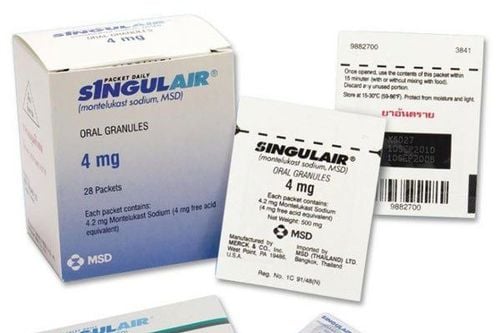
Thuốc singulair 4mg được dùng trong điều trị và dự phòng hen phế quản mạn tính
2. Dosage and usage
2.1. Dosage “Is Singulair an antibiotic and what dose is reasonable?”. Accordingly, the drug Singulair contains the active ingredient Montelukast, which is not an antibiotic, the drug is used in the treatment and prevention of bronchial asthma. Dosage of Singulair depends on the age and condition of the patient, specifically as follows:
Adults and adolescents 15 years of age and older with bronchial asthma or allergic rhinitis: Dosage is 10mg/time/day . Children from 6-14 years old with bronchial asthma or allergic rhinitis: The dose is 1 chewable tablet 5mg/day. Children from 2 to 5 years old with bronchial asthma or allergic rhinitis: The dose is 1 chewable tablet 4mg/day or 1 pack of granules 4mg. Children from 6 months old to 2 years old: Dosage is 1 pack of granules 4mg/day. 2.2. How to use granules Singulair granules can be taken by mouth or tongue, sprinkled with a spoonful of soft food at room temperature, or dissolved in 1 teaspoon of breast milk (or liquid infant feeding at room temperature). Only open the package of singulair just before taking it. Once opened, the entire dose of Singulair granules should be reconstituted and administered immediately (within 15 minutes). Medicines after mixing with food or breast milk should not be kept for future use. Singulair granules must not be mixed with other solutions except infant nutrition and breast milk.
2.3. General recommendations The therapeutic effect of the drug in the treatment of asthma is reached after 1 day. The drug can be taken in the form of chewable tablets, tablets and SINGULAIR granules to be taken with or without food. The patient should be maintained on medication even when the asthma is under control as well as during periods of worsening asthma.
No need to adjust the dose in elderly patients, pediatric patients in each age group, patients with renal impairment, patients with mild and moderate hepatic impairment.
3. Undesirable effects
Some unwanted effects may be encountered when using Singulair 4mg, 5mg or 10mg drugs as follows:
Parasitic and bacterial infections: Upper respiratory tract infections. Lymphatic system and blood disorders: Thrombocytopenia, increased bleeding tendency. Immune system disorders: Anaphylaxis and hypersensitivity reactions, very rarely eosinophilic infiltration. Psychiatric Disorders: Anxiety, agitation including opposition and aggressive actions, depression, attention disorders, disorientation, hallucinations, abnormal dreams, memory impairment, sleepwalking, psychosis – hyperactivity, suicidal thoughts and behavior. Nervous system disorders: Drowsiness, paresthesia, dizziness (abnormal sensation), very rarely convulsions. Heart disorders: Palpitations. Chest, respiratory and mediastinal disorders: Eosinophils pulmonary disease, nosebleed. Gastrointestinal disorders: Anorexia, diarrhea, vomiting and nausea. Hepatobiliary disorders: Increased AST and ALT, very rarely hepatitis (including hepatocellular, cholestatic hepatitis, multicomponent liver damage). Subcutaneous tissue and skin disorders: Bruising, angioedema, pruritus, erythema multiforme, urticaria, rash. Musculoskeletal and Connective Tissue Disorders: Myalgia, arthralgia including cramps. Urinary and renal disorders: Bedwetting in children. Drug site disorders or systemic disorders: Fatigue, asthenia, fever, edema.

Người bệnh có thể gặp một số tác dụng phụ khi dùng thuốc singulair 4mg
4. Note when taking medicine
4.1. Contraindications Contraindicated to use the drug in any patient allergic to the drug.
4.2. Precautions for use The efficacy of Singulair has not been established in the treatment of patients with acute asthma. Therefore, do not use oral medications to treat acute asthma.
Patients can gradually reduce the dose of corticosteroids with the supervision of a doctor, but do not suddenly replace oral corticosteroids or inhaled with singulair.
Neuropsychiatric effects in patients treated with Singulair have been reported. Physicians should discuss these adverse effects with the patient or caregiver.
Rarely, patients taking Singulair and other anti-asthmatics, including leukotriene receptor antagonists, may develop the following symptoms: Vasculitis-type rash, eosinophilia, respiratory symptoms worsening, neurological disease or heart complications...
Drivers and machines: Singulair does not affect the ability to drive and use machines. However, individual patient response to the drug may vary, and singulair has been reported to affect the ability to drive and use machines in some patients.
Pregnant women: There are no studies on the safety of the drug in pregnant women, so use the drug only when absolutely necessary.
Lactating women: The drug is excreted in breast milk, so the mother should be cautious when taking the drug while breastfeeding.
5. Drug interactions
Drug interaction studies showed that therapeutic doses of Montelukast did not affect the pharmacokinetics of the following drugs: Prednisone, Theophylline, Prednisolone, Oral contraceptives (ethinyl) estradiol/norethindrone, digoxin, terfenadine, warfarin.
Concomitant administration of Singulair and Phenobarbital (a hepatic metabolite) decreased the plasma area of the drug by approximately 40% at a single 10 mg dose of Montelukast. Therefore, clinical monitoring is required in case of combination of these drugs.
Concomitant use of Singulair and itraconazole did not significantly increase the systemic exposure of Montelukast.
Please dial HOTLINE for more information or register for an appointment HERE. Download MyVinmec app to make appointments faster and to manage your bookings easily.




